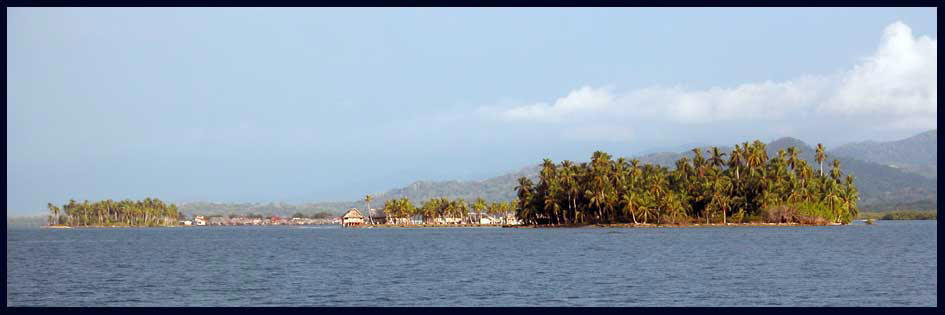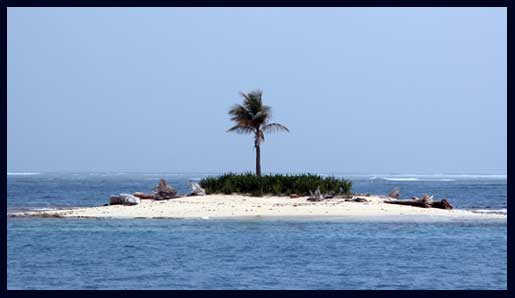

| Santa Marta is a windy place and until one passes the coast of
Cartegena and the Golfo de Uraba opens up, relieving the compression caused by
the Andes, it
continues to be windy. Plus there's the added excitement of the Rio
Magdalena's output which often carries delights like tree trunks and dead cattle
way out to sea - and the rains this year had been exceptional. So being
strongly addicted to comfort rather than speed we were happy to wait for almost
perfect conditions. And finally they arrived. Then we found a pool
of water leaking into the bilge. Salt water. Turned out not to be
serious, but delayed us a couple of days. Weather still looked good so
then we left. After about a mile, we couldn't motor at more than a couple
of knots and we were slowly, slowing down. Back to marina. Barely
made it onto the pontoon. Again, nothing serious, just a plugged fuel
filter, but we were beginning to consider Colombian residency as an option at
this point. But weather still good, the complications of trying to clear
back in without actually having left were likely to be unimaginable, so finally,
finally we headed west. San Blas here we come!
A pretty uneventful trip, with an all too quick overnight stop at the San Bernardo archipelago (palm trees, coral reef, sparkling water, etc). Then we set sail for the final 140 mile hop to the San Blas. It was that or wait more than a week for the next decent weather window and it's now the end of March and we only have a month before the rainy season starts. Sailing is often like that. You have to leave places you like too soon only to get stuck somewhere you don't like for ages! |
|
| First a bit about the San Blas (or more correctly
Guna Yala) which you can skip if you already know about them:
A long narrow coastal strip with off-lying islands and reefs running North West roughly 100 miles up the Panamá coast from the Colombian border, inhabited and governed by the Guna Indians as a semi-autonomous state within Panamá. In the mid 18th century the Guna rebelled against the Spanish colonists and since then the Comarca of Guna Yala has continued to be semi-independent, governed according to traditional Guna laws and customs. Of course there's the age old struggle of balancing the preservation of a culture on the one hand with provision of modern health, hygiene, education, etc on the other. |
|
| And there's no doubt that particularly as
one moves north the presence of the 21st century becomes more apparent.
Nowhere more so than Narganá, which has what we believe to be the
noisiest generator on the planet running 24x7, the noise steadily
increasing as dusk falls and more lights come on together with the
occasional semi-communal television!
But, in spite of this and the fact that Guna Yala is less than 50 miles from Panamá City (as the crow flies) and that the Guna population is only about fifty thousand, they have by and large preserved their life style, the good and the bad, to a remarkable extent. |
|
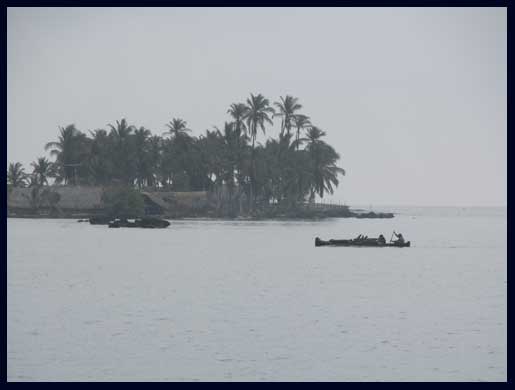 |
Their success preserving their traditional way of
life is partly because of physical isolation and partly a direct result
of the traditions themselves. First, Guna Yala isn't particularly
easy to get to - until recently access was restricted to a small handful
of airstrips for light aircraft or a tedious boat ride from Colombia or
Colón. There is now a winding mountain road through rain
forest connecting to the
main highway on the Pacific side. It's paved, but you'd be unwise to attempt it without a 4x4,
and bits of it get washed away in the rainy season. And then the Guna close the border
well before sunset every evening. That fits in with the Guna tradition of each island
community meeting every evening in the "congreso" to discuss the day's
events and take decisions, and the fact that non Guna are not generally welcome
on their inhabited islands after dark. And all the Guna do live on the islands
(some of them are incredibly overcrowded). They may go to the mainland to tend their
vegetable plots, etc, but they live on the islands - historically it's always
been safer that way. Then only Guna can own land - generally communally - and only Guna can run businesses which taken together puts a real brake on the volume of tourism and any inward investment. There are hotels, not many, but they're all Guna run and on small islands where there is no Guna community. They're also not quite hotels as you know them - unless that is you normally stay in hotels with hammocks instead of beds and extremely limited sanitary facilities. Also Guna society is very rigid. A Guna can't even visit another island without his chief's permission. Guna can only marry Guna so no back door into owning a bit of Guna Yala that way. Nowadays, marrying a non Guna would lead to expulsion, but such is the Guna commitment to their racial purity that during the uprising they put everyone of mixed race to death. So there's not even any residual foreign genes from the Spanish conquest. |
| All of which means that the Guna remain distinctive and easily identified, even if they make their way to the cities and not just because of the women's traditional dress. | |
| So that's Guna Yala - a virtually crime free tropical
island paradise of coral reefs, palm islands, flat seas and no
hurricanes, inhabited by a seemingly charming, placid and tiny people
(only pigmies are smaller) who seem to spend a large part of their
lives lying in hammocks. Seriously if hammock lying ever becomes
an Olympic sport it won't really be worth any other countries even
sending competitors.
The Guna are mostly not much interested in the outside world or the travellers who trickle through their country, other than to sell them lobsters or molas. Though visiting yachts do provide a convenient way of getting their cellphones charged - even Guna on islands without electricity have cellphones, but no immediate way of charging them. We once watched a Guna mother and daughter paddling their ulu around the bay where we were anchored, in seemingly aimless eccentric circles. What were they doing? They certainly had no fishing lines. Were we witnessing some obscure native ritual? No, what they were doing was desperately trying to find that one spot near their island where there was cellular reception. Once found, one short call and they were gone! The whole process of paddling ulus seems effortless and is mostly silent. A spooky side effect of this is that one can be in a solitary anchorage, sitting on deck doing something nautical, or maybe nothing very much at all, when suddenly a little brown head will pop up over the bulwarks out of nowhere - "Hola, langosta?" or "Coconuts?" or, of course "Molas?". A defibrillator would be a good thing to have on board at moments like these! |
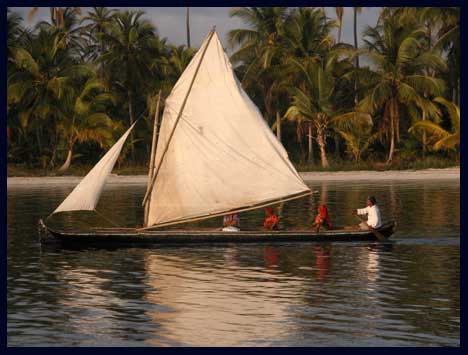 |
| The complex of reefs which protects Guna Yala and makes it such a perfect sailing area, mean that there are only a very small number of places where a deep drafted yacht can safely enter. We chose to enter the channel south of Isla Pinos about 20 miles north of the Colombian border. Not quite the southern extremity of Guna Yala, but none-the-less in a very traditional area. | |
| We went ashore to explore and for our first exposure to
Guna culture. A few dozen huts dominated by the congreso - empty now,
but presumably full at dusk. A few Guna going about their business,
polite, but not much interested in us. Why should they be? And on
the outskirts of the village we discovered a small catholic church which is
where most of the children seemed to be for some sort of bible study class.
We discovered two "shops". That is two huts that had a hole in the wall
and a couple of shelves of low quality canned goods, rice, flour, sugar, dried
beans, etc. No cold things of course, the island has no electricity (nor
any running water) and no vegetables, because all the Guna grow their own on
their mainland allotments. But the shop #1 closest to the jetty, which had the
chattiest owner, had (warm) beer and was proud also to be able to
offer a large plastic bucket of salted pigs tails. Lindy however was not
to be tempted, neither by the (warm) beer nor the pigs tails, salted or not. It was here that we also experienced our first exposure to the strictness of Guna life. A young Guna guy who'd learned enough English to interact with cruisers, took some American friends ashore to the mainland to show them how the Guna grew their vegetables, but he did so without permission from the chief/congreso - and so was duly fined. The Guna in the traditional islands were also prohibited from selling any produce to the visiting yachts. After Pinos we headed north and the log is filled with lots of:- anchored off palm fringed beach, visited Guna village, snorkelled on reef, dolphins (or rays or sharks) in the anchorage, etc and less frequently with:- bought chicken, bought onions, etc. |
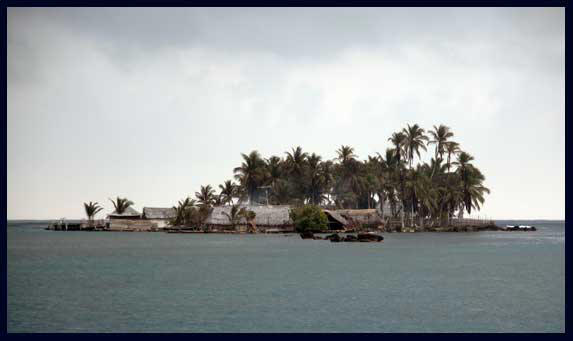 |
| But there is a rhythm to the life in Guna Yala and once you learn when and where you're likely to meet a veggie boat, where you might find a chicken, or an internet connection or some gasoline, etc then it's easy to understand why there are cruisers who come back here year after year after year. Though it has to be said, having a big freezer (or maybe regular helicopter deliveries) would make life much more civilized. | |
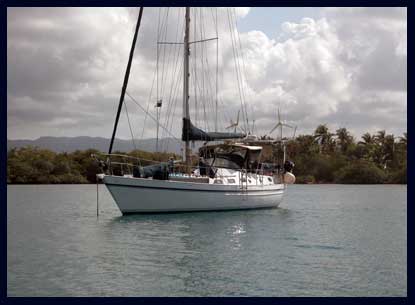 |
All very beautiful, but we were beginning to face a
very practical problem with this idyllic lifestyle. We were running out of cash.
We thought we'd come well supplied, but after a while the stocks began to
dwindle. There are no ATMs in Guna Yala and no one takes credit cards.
There is one bank, but it doesn't dispense cash, or certainly not to foreigners.
Well capitalism abhors a vacuum, and a small group of Guna had set up a business
offering Guna Yala - Panamá City package deals. So we anchored the boat in
the West Lemons, were picked up by a panga for the fast, wet and scary 30 minute boat trip to Carti.
(Non optional smack in the head with a flying fish included free of charge -
wonder who was most surprised, him or me?) Then a 3 hour 4x4 trip to Panama. 3 days
of shopping, shopping, shopping, then back to Carti with half a roof rack of
goodies and our pockets once again full of Dollars. Two other things were to force us to leave this little piece of paradise. The first was the watermaker. Regular readers will know that in the seven years since installation, our Schenker watermaker has been the most problematic piece of kit on the boat by a long, long way. |
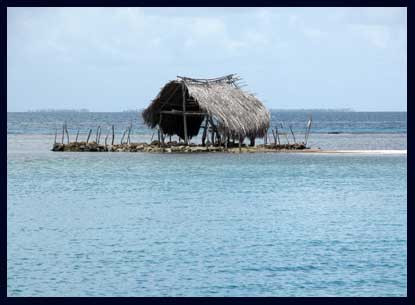 |
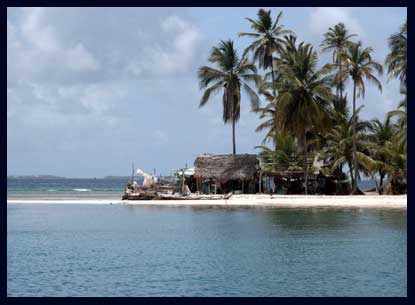 |
Anyway after yet another total rebuild in
Colombia it had failed catastrophically when a membrane end cap split
spraying the engine room with high pressure salt water. We'd
jury-rigged it to run at low output on just one of the remaining
membranes, but enough was enough, this was the perfect excuse to scrap
it and buy something with higher output and hopefully more reliable. After years of watermaker discussions with other boats we knew exactly what we wanted - A Cat pump driven by a 220v electric motor and two 40 inch membranes. Not particularly efficient or sophisticated but 160 litre/hour plus and (hopefully) very reliable. We'd had enough of sophisticated efficiency! The whole package was to be provided by Barry Day in Curacao who we'd known for years and has an enviable reputation. The trick now would be getting it to San Blas without incurring huge shipping costs. Normally there's a regular flow of boats in this direction so even at this time of year shouldn't be too difficult to find one that was willing to bring it for us. And after a few false starts we found Simon on Kaitlyn. Well as we all are, he was delayed. Delayed by repairs, waiting for parts, weather, crew etc. Eventually, he was so delayed that he would have to skip the San Blas and head straight for Colón and the Panama Canal. Not a problem we would also head west to meet him. That was the first thing that forced us to leave, the other was the lightning! It was worse than anything we had ever experienced. It was every few days and during each storm it seemed another boat was struck (6 by the time we left). During one particularly bad storm, when the strikes were being timed at one every two seconds we had a bolt hit the water no more than 20 meters behind us! We heard no thunder, just a simultaneous hiss and flash, and we saw the water boil.
|
|
| Enough! Our nerves couldn't take much more of
this. We had been in the San Blas for 3 months, nearly July and
time to go. So west we headed. Isla Grande then Portobelo - not really a "Porto" and not so "Belo" particularly in a westerly wind we can assure you, but a large natural harbour with a small village and a bus to Colon. We met up with many friends here including Gilles who had his boat impounded in Santa Marta, and Mark & Amanda from Balvenie who we had met in the San Blas. Two weeks later we got the word and headed for Shelter Bay marina in Colón, together with Balvenie. We arrived several days before Simon - such had been his delays that one of his crew for the Pacific crossing would now arrive in Colón before him and we had offered to be there to put him up until Kaitlyn arrived. |
|
|
